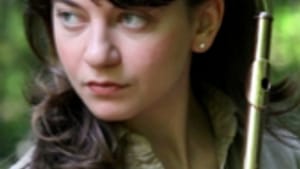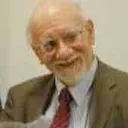Stay in the Loop
BSR publishes on a weekly schedule, with an email newsletter every Wednesday and Thursday morning. There’s no paywall, and subscribing is always free.
Songs, souvenirs, and a winning premiere
Dolce Suono honors Barber, again

When Jennifer Higdon introduced her Autumn Music at Dolce Suono's January concert at Curtis, she noted that she had composed it when she was still a student and it had never occurred to her that it might be performed on the same program as the work it was modeled on: Samuel Barber's Summer Music. Another up and coming young composer, Benjamin C.S. Boyle, had a similar experience at Dolce Suono's latest event. Mimi Stillman and Charles Abramovic played the premiere of his Sonata-Cantilenafor Flute and Piano right after they played Barber's 1959 Canzone for the same instruments.
Higdon's wind quintet weathered the comparison with flying colors, and Boyle looked just as good. Barber wrote his Canzone for an amateur flutist, and it's a beautiful work that emphasizes the flute's ability to trace attractive melody lines. Boyle composed his entry for Mimi Stillman, one of the most accomplished flutists most of us will ever hear, and he was therefore able to produce something that was much more complex and varied. Boyle's flutist obviously had to put plenty of work into her performance, but he created music worthy of the effort.
Boyle also remembered to write a piano part while he was at it. In any piece for piano and another instrument, there's a natural tendency to focus on the other instrument and think of the piano as background. But it would be a mistake to listen to this piece without listening to the piano.
Welcome reminder
This Dolce Suono program was the second entry in a two-part series commemorating the hundredth anniversary of Barber's birth. It was a highly varied program that provided a welcome reminder that Barber wrote more than one piece.
It did, however, include That Piece. And I had no problems listening to one more hundredth-anniversary performance of Barber's one and only String Quartet and its ubiquitous adagio. The adagio meets one of the primary tests that every classical work must pass. I hear something different in it every time a chamber ensemble schedules it.
The Dolce Suono forces included a guest pianist, Barber's friend Charles Wadsworth, who joined Charles Abramovic in a set of Souvenirs for four hands. Wadsworth invited the audience to think of the souvenirs as salon music, and the set did include a tango, a waltz and a gallop. But Barber made good use of the extra pair of hands and added complexities that raised them to a higher level.
Hint of raindrops
Barber's songwriting talents received special attention, with Randall Scarlata doing the vocal honors. Three Songs, to texts by James Joyce, begins with a hint of raindrops in the piano accompaniment to Joyce's poem, Rain Has Fallen, and ends with music that adds storm and fury to a text about green-haired armies rising from the sea. Joyce's detailed vision in the last poem is sufficiently graphic to suggest that he could have made a good living writing for 1920s pulp magazines like Weird Tales.
The Joyce poems have their declamatory moments, but Barber also knew when to be simple— an important virtue in a song composer. His Song for a New House is a piece d'occasion composed as a housewarming present for Mary Curtis Bok when she moved into a new house on Delancey Street. Barber embellished excerpts from A Midsummer Night's Dream with sprightly interactions for flute, piano, and voice where that was appropriate, but he wisely let Shakespeare's words do most of the work when he reached the peaceful ending.
Stillman takes a back seat
Mimi Stillman may be the director and founder of Dolce Suono, but she seems to be happy to yield the spotlight to other performers. She sat out the entire second half of the program and passed the instrumental work to a string quartet that included four A-list Philadelphia chamber musicians: violinists Hirono Oka and Igor Szwec, violist Burchard Tang and cellist Yumi Kendall. They could have brought the evening to a satisfactory close with the aforementioned Barber quartet. Instead, they played the quartet first and then joined Randall Scarlata for a closer that's just as popular among knowledgeable chamber enthusiasts: Barber's setting for Matthew Arnold's poem, Dover Beach.
Dover Beach is one of the most famous poems any poet ever put on paper, and Barber used the quartet to give it a background that evokes the wistful melancholy of the nighttime seaside setting. Randall Scarlata hit the last section with more force than I would recommend if I were a vocal coach, but that's a matter of taste.
For me, Arnold's last two lines are a straightforward statement of the facts. But other people, I realize, have a stronger reaction to the idea that we live on a darkling plain, where ignorant armies clash by night.
Higdon's wind quintet weathered the comparison with flying colors, and Boyle looked just as good. Barber wrote his Canzone for an amateur flutist, and it's a beautiful work that emphasizes the flute's ability to trace attractive melody lines. Boyle composed his entry for Mimi Stillman, one of the most accomplished flutists most of us will ever hear, and he was therefore able to produce something that was much more complex and varied. Boyle's flutist obviously had to put plenty of work into her performance, but he created music worthy of the effort.
Boyle also remembered to write a piano part while he was at it. In any piece for piano and another instrument, there's a natural tendency to focus on the other instrument and think of the piano as background. But it would be a mistake to listen to this piece without listening to the piano.
Welcome reminder
This Dolce Suono program was the second entry in a two-part series commemorating the hundredth anniversary of Barber's birth. It was a highly varied program that provided a welcome reminder that Barber wrote more than one piece.
It did, however, include That Piece. And I had no problems listening to one more hundredth-anniversary performance of Barber's one and only String Quartet and its ubiquitous adagio. The adagio meets one of the primary tests that every classical work must pass. I hear something different in it every time a chamber ensemble schedules it.
The Dolce Suono forces included a guest pianist, Barber's friend Charles Wadsworth, who joined Charles Abramovic in a set of Souvenirs for four hands. Wadsworth invited the audience to think of the souvenirs as salon music, and the set did include a tango, a waltz and a gallop. But Barber made good use of the extra pair of hands and added complexities that raised them to a higher level.
Hint of raindrops
Barber's songwriting talents received special attention, with Randall Scarlata doing the vocal honors. Three Songs, to texts by James Joyce, begins with a hint of raindrops in the piano accompaniment to Joyce's poem, Rain Has Fallen, and ends with music that adds storm and fury to a text about green-haired armies rising from the sea. Joyce's detailed vision in the last poem is sufficiently graphic to suggest that he could have made a good living writing for 1920s pulp magazines like Weird Tales.
The Joyce poems have their declamatory moments, but Barber also knew when to be simple— an important virtue in a song composer. His Song for a New House is a piece d'occasion composed as a housewarming present for Mary Curtis Bok when she moved into a new house on Delancey Street. Barber embellished excerpts from A Midsummer Night's Dream with sprightly interactions for flute, piano, and voice where that was appropriate, but he wisely let Shakespeare's words do most of the work when he reached the peaceful ending.
Stillman takes a back seat
Mimi Stillman may be the director and founder of Dolce Suono, but she seems to be happy to yield the spotlight to other performers. She sat out the entire second half of the program and passed the instrumental work to a string quartet that included four A-list Philadelphia chamber musicians: violinists Hirono Oka and Igor Szwec, violist Burchard Tang and cellist Yumi Kendall. They could have brought the evening to a satisfactory close with the aforementioned Barber quartet. Instead, they played the quartet first and then joined Randall Scarlata for a closer that's just as popular among knowledgeable chamber enthusiasts: Barber's setting for Matthew Arnold's poem, Dover Beach.
Dover Beach is one of the most famous poems any poet ever put on paper, and Barber used the quartet to give it a background that evokes the wistful melancholy of the nighttime seaside setting. Randall Scarlata hit the last section with more force than I would recommend if I were a vocal coach, but that's a matter of taste.
For me, Arnold's last two lines are a straightforward statement of the facts. But other people, I realize, have a stronger reaction to the idea that we live on a darkling plain, where ignorant armies clash by night.
What, When, Where
Dolce Suono: “Samuel Barber at 100, the Composer and His World.†Barber, Three Songs, Canzone for Flute and Piano, Souvenirs, Song for a New House, String Quartet in B Minor, Dover Beach; Boyle, Sonata-Cantilena for Flute and Piano. Mimi Stillman, flute; Hirono Oka and Igor Szwec violins; Burchard Tang, viola; Yumi Kendall, cello; Charles Abramovic and Charles Wadsworth, piano. February 17, 2010 at First Unitarian Church, 2125 Chestnut St. (267) 252-1803 or www.dolcesuono.com.
Sign up for our newsletter
All of the week's new articles, all in one place. Sign up for the free weekly BSR newsletters, and don't miss a conversation.

 Tom Purdom
Tom Purdom